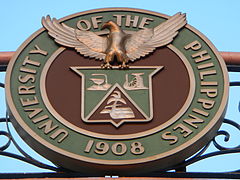Uniwersytet Filipiński
 | |
| Dewiza | Honor and Excellence |
|---|---|
| Data założenia | 18 czerwca 1908 |
| Typ | państwowy |
| Państwo | |
| Adres | University Avenue, Diliman, Quezon City |
| Liczba pracowników | 4571 |
| Liczba studentów | 52,4 tys. (w całym systemie) |
| Rektor | Alfredo E. Pascual (prezes uniwersytetu) |
| Strona internetowa | |
Uniwersytet Filipiński (UP) (ang. University of the Philippines, tagalski Unibersidad ng Pilipinas) – państwowy uniwersytet na Filipinach, mający 7 uniwersytetów składowych w 12 kampusach w całym kraju zorganizowanych jako system uniwersytetów.
Uniwersytet został założony 18 czerwca 1908 w Manili przez pierwsze Zgromadzenie Filipińskie podczas panowania amerykańskiego. W 1949 roku, po II wojnie światowej, główne biura uniwersytetu przeniesiono do nowego kampusu głównego w Diliman, Quezon City (Narodowy Region Stołeczny, aglomeracja manilska). Rezolucja Senatu w 2008 roku uznała system Uniwersytetu Filipińskiego za najważniejszy uniwersytet na Filipinach[1].
Uniwersytet Filipiński ukończyło wielu filipińskich intelektualistów i urzędników.
7 prezydentów Filipin studiowało na uniwersytecie na studiach licencjackich czy podyplomowych. 12 prezesów Sądu Najwyższego, 36 artystów narodowych, oraz 34 naukowców narodowych Filipin jest powiązanych z uniwersytetem.
Przypisy
- ↑ Defensor Santiago, Miriam: Rezolucja Senatu nr. 276: A Resolution Expressing the Sense of the Senate to Honor the University of the Philippines in its Centennial Year as the nation's premier university, itd. (ang.). 2008. s. Senat Filipin. [dostęp 2013-06-06].
Linki zewnętrzne
- Oficjalna strona uczelni (ang.)
Media użyte na tej stronie
Autor: Ramon FVelasquez, Licencja: CC BY-SA 3.0
The Oblation and Academic Oval - Oblation (University of the Philippines) Quezon Hall - [1]The Oblation (Filipino: Pahinungod, Oblasyon) is a concrete statue by Filipino artist Guillermo E. Tolentino which serves as the iconic symbol of the University of the Philippines. It depicts a man facing upward with arms outstretched, symbolizing selfless offering of oneself to his country. Oblation Run[2] University of the Philippines Diliman[3]The U.P. Diliman campus is connected to Commonwealth Avenue via the University Avenue. It stretches 800 meters where traffic enters the campus, or proceeds towards C.P. Garcia St., which connects Commonwealth Avenue to Katipunan Avenue. At the end of University Avenue, the Oblation Plaza of the Diliman campus faces the road. Behind it, the facade of Quezon Hall can be seen. The Gen. Antonio Luna Parade Grounds, or commonly known as the Sunken Garden, is a 5-hectare natural depression found on the eastern side of the campus and at the end of the Academic Oval circle. Sunken Garden is enclosed by the U.P. Diliman Main Library (also houses the School of Library and Information Studies), College of Social Sciences and Philosophy's Department of Psychology, College of Education, Student Activity Center/Vinzons Hall, College of Business Administration, School of Economics and College of Law. The Grounds was originally a property of the UP Reserved Officers' Training Corps when the campus was founded in 1949.
Autor: NordNordWest, Licencja: CC BY 3.0
Location map of the Philippines




